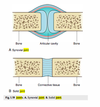LEC 2: The Vertebral Column - 08.18.2014 Flashcards
(63 cards)
The skeletal system is composed of two (2) skeletons…
- Axial Skeleton
- Appendicular Skeleton
Componenets of axial skeleton
- skull
- vertebral column
- sternum
- ribs
Componenets of appendicular skeleton
- extremities
What are the five (5) sections of the vertebral column and how many vertebrae do they have?
- cervical spine (7)
- thoracic spine (12)
- lumbar spine (5)
- sacral spine (5 - fused)
- coccygeal spine (4)
TOTAL: 33 vertebrae (typically)
Kyphosis
curvature of the spine causing bowing, rounding of back (“hunchback”) in thoracic section

Lordosis
abormal curvature of vertebral column in lumbar region, produces swayback deformity

Describe the primary curvature of the spine
Primary curvature is concave anteriorly (bending toward anterior)
- represents original shape of embryo
- retained in thoracic/sacral regions in adults
Describe the secondary curvature of the spine
Secondary curvature is concave posteriorly (bending toward posterior)
- occurs in cervical/lumbar regions in adults
- brings center of gravity into vertical line
Describe the order of curvatures in the spine
- thoracic kyphosis is first (primary)
- when infant lifts head, lordosis occurs in cervical region (secondary)
- when infant begins to crawl, lordosis occurs in lumbar region (secondary)
- later, sacrum lifts (primary)
Dowager’s Hump
example of an abnormal vertebral column curvature (extreme kyphosis in thoracic region)

Describe a situation of tranisent lordosis
typically found in pregnant women due to massive shift in center of gravity (lumbar region)

Where does the spinal cord end?
- Technically, cord ends between L1-L2
- Does NOT mean that sacral/coccygeal portions of spinal cord do not exist – just not 1-to-1 with exit wholes
Name the parts of a “typical” (lumbar) vertebra
- body
- vertebral (neural) arch
- formed by (2) pedicles and (2) lamina
- (7) processes project from vertebral arch
- (2) transverse
- (4) articular
- (1) spinous
How many processes project from the vertebral arch (lumbar) and name them
- (2) transverse processes
- (4) articular processes
- (1) spinous process

What is the hole between the vertebral body and the vertebral arch called
Vertebral foramen
cervix
Latin for “neck”; e.g. cervix is the neck of the uterus
C1
Atlas; does not have vertebral body and articulates with the bottom of the skull

C2
Axis; has the dens, which is the body of C1 that has become fused to C2 during development

C7
Vertebra promenens
Cervical rib
Rare occasion when (in humans) a rib may attach to C7 (vertebra promenens); may or may not be clinically relevant
Distinguishing characteristic of cervical vertebrae
hole (foramen) in transverse processes; vertebral artery and vertebral veins are located here
Distinguishing characteristics of thoracic vertebrae
- increase in size from T1 to T12
- all thoracic vertebrae articulate with ribs and have either “full” facets or “demi” facets for attachments
“Full” facet or “demi” facet
Found in the thoracic vertebrae; imporant for the attachment and articulation of ribs
Distinguishing characteristics of lumbar vertebrae
- largest of the vertebrae
- lack foramina in the transverse processes
- lack facets for rib articulation
- L4 and L5 often involved in disc related injuries due to position and weight transmission




















